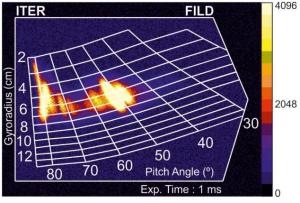Measuring the behaviour of fast ions in the plasma
A diagnostic probe, called the "lost alpha monitor," is being carefully designed to measure the behaviour of escaping ions.
The lost alpha monitor will be part of the system that measures fast ions escaping from the ITER plasma. These ions are generated in the core plasma by fusion reactions (alpha particles) and plasma heating systems. Due to various plasma instabilities, the fast ions can escape the core plasma and ultimately hit ITER plasma-facing components.
Maximizing fast ion confinement will help the ITER project reach its objectives. As the fast ions escape the core, they remove energy, thereby reducing plasma performance. When they reach a high enough flux, they can also damage the reactor first wall. The purpose of measuring these particles in ITER is to gain understanding as to how fast ions are transported to the edge plasma by plasma instabilities. Knowing how escaping fast ions are produced will help design tokamaks that minimize their occurrence—something that will be necessary for DEMO and subsequent commercial fusion devices.
The lost alpha monitor diagnostic probe will sample populations of the fast particles to figure out what their energies are. This analysis will be correlated with what is known about the current state of the plasma and hence improve the models that predict how plasma instabilities generate escaping fast ions.
An existing diagnostic adapted to ITER
"ITER diagnostics are normally passive, in the sense that they stay far behind the first wall," says Martin Kocan, Diagnostics Coordinating Scientist in the Ex-Vessel Diagnostics Section. "But we couldn't find an approach that would make passive measurements work for fast ions. So we are designing an active system—a detector that comes into the very edge of the plasma."
"We are planning to develop a movable probe, which has a six-metre-long shaft driven by an electric motor to push the probe into the very edge of the plasma. That's roughly at the level where the ITER first wall is. At the tip of this moving system will be a probe head with a small pinhole, through which ions will pass. Inside this probe head, we will have what we call a scintillator plate, which is a 2-dimensional array based on special material that emits visible light when hit by energetic ions."
"If you could peer inside the probe head you would see a plate with patches of light where ions hit. A system of mirrors will transfer the image from the scintillator to a fast-framing camera. The position of the light on the scintillator tells you the energy and velocity of the ions."
This kind of diagnostic probe is already used in fusion reactors around the world, where they are officially referred to as "fast ion loss detectors." The concept is well understood, but ITER has some unique features that require innovation. For example, ITER needs to deploy a rugged scintillator so that it can survive plasma radiation over many years of operation. The scintillator will be backed by an array of electric detectors, called Faraday cups, which will provide similar information should scintillator performance degrade over time. Also, at ITER there is much stronger emphasis on preventing damage to the movable probe that could result in reactor downtime.
ITER refers to this system as the "lost alpha monitor" because the diagnostic was originally intended for the measurement of helium ions (alpha particles) produced by fusion reactions and "lost" in the plasma periphery. However, the diagnostic can sample any fast ions with megaelectronvolt energies ejected from the core plasma.
"To design this system, we established new collaborations with the UKAEA [the UK Atomic Energy Authority] and the University of Seville in Spain," says Kocan. "Both of these partners have strong experience with this kind of diagnostic and the associated engineering. We also work with EUROfusion and Aalto University in Finland on the modelling for this diagnostic."
A design that is safe and robust
During operations, other systems will detect whether fast ions are being produced. Then a decision can be made to either plunge the probe into the reactor during the same pulse, or to repeat the pulse and deploy the probe at the right time next time.
The probe will go in for a second or two and then retract back to a safe position to avoid overheating. One design alternative would be to have a diagnostic permanently in place. But that would require water cooling, which carries a risk. A pipe in a moving system could break and leak—and then operations would have to stop to remove the port, find the leak, and repair it.
Design features were specifically added to make sure a failure inside the diagnostic would not stop ITER operation. For example, one set of features prevents the system from going deeper than a shallow position at the very edge of the plasma. Another set of features prevents the operator from damaging the tokamak by inadvertently mistyping the position or by entering a position based on an incorrect assessment of where the plasma is. And a third way of preventing shutdown is that if the motor that drives the probe fails, the system can still be retracted and closed off, without losing important machine operation time.
"Not only do we need this lost alpha monitor to inform future tokamak designs, but it is also important for the operation of ITER," emphasizes Kocan. "We will optimize the design and ensure that it forms part of the eyes and ears of ITER."


